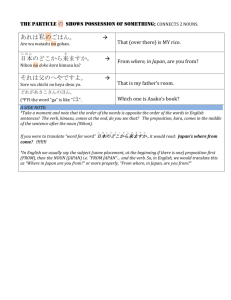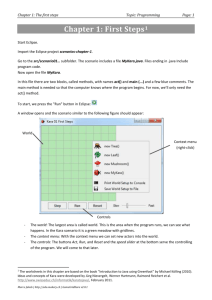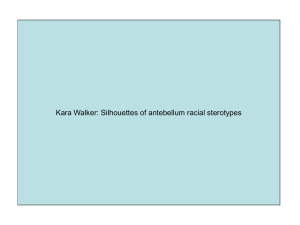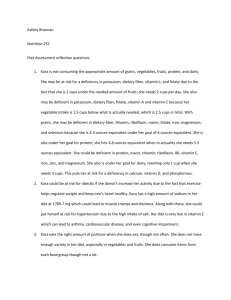Chapter 3: Variables
advertisement
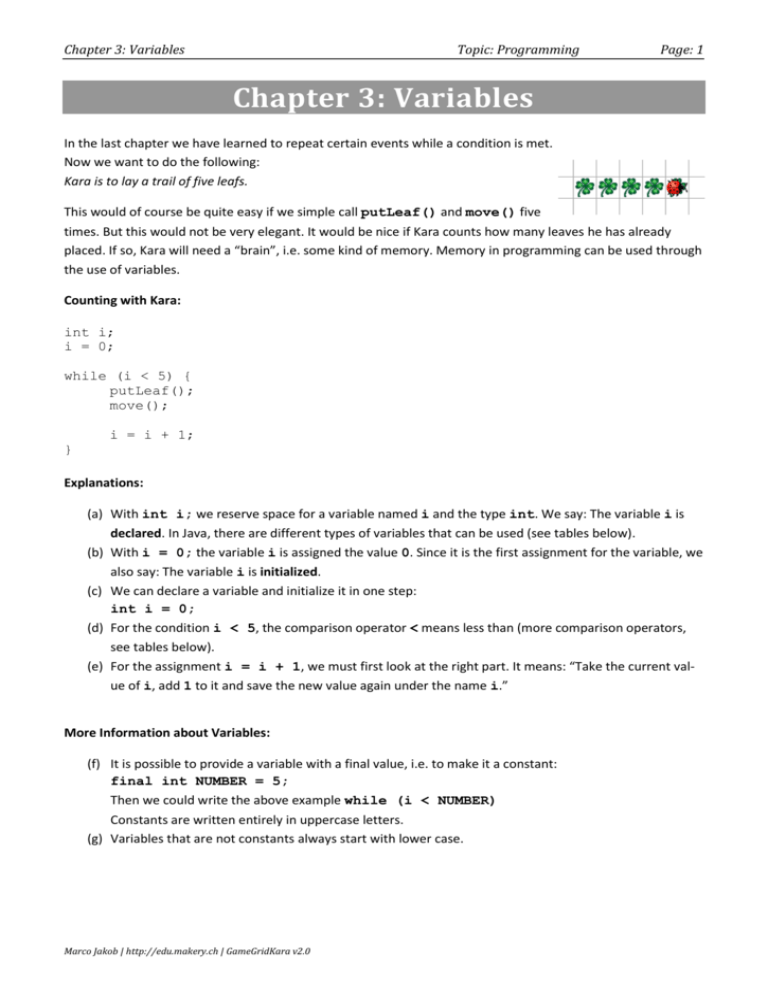
Chapter 3: Variables
Topic: Programming
Page: 1
Chapter 3: Variables
In the last chapter we have learned to repeat certain events while a condition is met.
Now we want to do the following:
Kara is to lay a trail of five leafs.
This would of course be quite easy if we simple call putLeaf() and move() five
times. But this would not be very elegant. It would be nice if Kara counts how many leaves he has already
placed. If so, Kara will need a “brain”, i.e. some kind of memory. Memory in programming can be used through
the use of variables.
Counting with Kara:
int i;
i = 0;
while (i < 5) {
putLeaf();
move();
i = i + 1;
}
Explanations:
(a) With int i; we reserve space for a variable named i and the type int. We say: The variable i is
declared. In Java, there are different types of variables that can be used (see tables below).
(b) With i = 0; the variable i is assigned the value 0. Since it is the first assignment for the variable, we
also say: The variable i is initialized.
(c) We can declare a variable and initialize it in one step:
int i = 0;
(d) For the condition i < 5, the comparison operator < means less than (more comparison operators,
see tables below).
(e) For the assignment i = i + 1, we must first look at the right part. It means: “Take the current value of i, add 1 to it and save the new value again under the name i.”
More Information about Variables:
(f) It is possible to provide a variable with a final value, i.e. to make it a constant:
final int NUMBER = 5;
Then we could write the above example while (i < NUMBER)
Constants are written entirely in uppercase letters.
(g) Variables that are not constants always start with lower case.
Marco Jakob | http://edu.makery.ch | GameGridKara v2.0
Chapter 3: Variables
Topic: Programming
Page: 2
Elementary Data Types in Java
These data types are called “elementary” because they are the basic data types in Java. (Later we will learn
how to create variable types for entire objects).
Integers and Characters
type
byte
short
int
long
char
from
-128
-32‘768
-2‘147‘483‘648
-9‘223‘372‘036‘854‘775‘808
0
up to and including
127
32‘767
2‘147‘483‘647
9‘223‘372‘036‘854‘775‘807
65‘635
memory required
8 bit
16 bit
32 bit
64 bit
16 bit
from
-3.4*1038
-1.7*10308
up to and including
3.4*1038
1.7*10308
memory required
32 bit
64 bit
range of values
true or false
memory required
1 bit
Floating Point Numbers
type
float
double
Logical Values
type
boolean
Comparison Operators
The following operators can be used for comparisons in Java. The result is always a boolean (either true or
false).
operator
<
<=
>
>=
==
!=
Note:
meaning
Kleiner als
Kleiner als oder gleich
Grösser als
Grösser als oder gleich
Gleich
Ungleich
example
k < 12
k <= 23
k > 67
k >= 45
k == 2
k != 32
The comparison to “equality” has always two equal signs ==. A single equal sign = is used for assignments!
Arithmetic Operations
To calculate we use the following arithmetic operators:
operator
+
*
/
%
meaning
Addition
Subtraktion
Multiplikation
Division
Modulo (liefert den Rest der Division)
Marco Jakob | http://edu.makery.ch | GameGridKara v2.0
example
h = wert + 34
z = 3.4 – t
value = h * 3.56
d = m / v
count = w % 2
Chapter 3: Variables
Topic: Programming
Page: 3
TASK 21: COUNTING LEAFS
Kara is going horizontally from left to right up to the tree and counting leafs.
Notes:
In the end, you can write the result with the following command to the 'console':
System.out.println(„The result is: “ + count);
Text must always be written in quotes. The plus sign is to append the value of the variable count
(which may of course be named differently).
Scope of variables: variables are visible only within the block (between the curly brackets), in which they are
declared. They can also be declared outside the methods in order to be visible to the entire class.
TASK 22: KARA IN A BOX I
A square area is surrounded by trees. Within the area is a set pattern of leafs,
that Kara should invert. Kara starts in the upper left corner with a view to the right.
Help:
In this task, it is helpful to work with boolean variables, e.g.:
boolean goingRight = false;
goingRight = !goingRight;
if (goingRight)
// declaration and initialization
// switches to true from false and vice versa
// boolean as a condition
ADDITIONAL TASK 23: KARA IN A BOX II
A square area is surrounded by trees. Within the area is a checkerboard-like pattern of leafs to be laid by Kara. Kara starts in the upper left corner with a view to
the right.
ADDITIONAL TASK 24: THE LONGEST TREE LINE
In this world there are several rows of trees. Kara is to determine the length (in number of trees) of the longest line of
trees and output to the result to the console. Between the
rows of trees is always at least one space. A leaf marks the
end of the world.
Marco Jakob | http://edu.makery.ch | GameGridKara v2.0
Chapter 3: Variables
Topic: Programming
Page: 4
ADDITIONAL TASK 25 (VERY DIFFICULT): PUSH MUSHROOM THROUGH TUNNEL
This world of Kara has two boxes connected by a tunnel. In the box on the left is Kara and a leaf. In the box on
the right is a mushroom. Kara is to get to the other side, find the mushroom then push it to the other side.
Once on the other side, the mushroom is to be pushed onto the leaf.
Kara always starts in the top left corner and the leaf is always in the bottom left corner. The Mushroom, on the
other hand, can be at an arbitrary position on the right side of the tunnel.
Note: This problem may be solved in pairs and in collaboration. Then some sub-problems can be divided
among each other:
-
Find the tunnel entrance
Find Mushroom
Place the Mushroom in the tunnel entrance
Push the Mushroom on to the leaf
Marco Jakob | http://edu.makery.ch | GameGridKara v2.0
Chapter 3: Variables
Topic: Programming
Page: 5
More about Variables
So far, we have had a quick introduction to variables. Now a few additional comments on the different types:
Elementary Data Types
boolean x = true;
x
x
x
boolean
byte
short
int x = 12;
x
x
int
long
Reference Types
Kara k = new Kara();
k.move();
Kara Object
The value in k is a reference to
the Kara-object. With the dot operator (k.)
k can be used like a remote control for the
k
Kara object!
Kara
Marco Jakob | http://edu.makery.ch | GameGridKara v2.0
Chapter 3: Variables
Topic: Programming
Note about Kara:
Ideas and concepts were developed by Jürg Nievergelt, Werner Hartmann, Raimond Reichert et al.,
http://www.swisseduc.ch/informatik/karatojava/, February 2011.
Some Kara exercises are based on material by Horst Gierhardt,
http://www.swisseduc.ch/informatik/karatojava/javakara/material/, February 2011.
Marco Jakob | http://edu.makery.ch | GameGridKara v2.0
Page: 6
